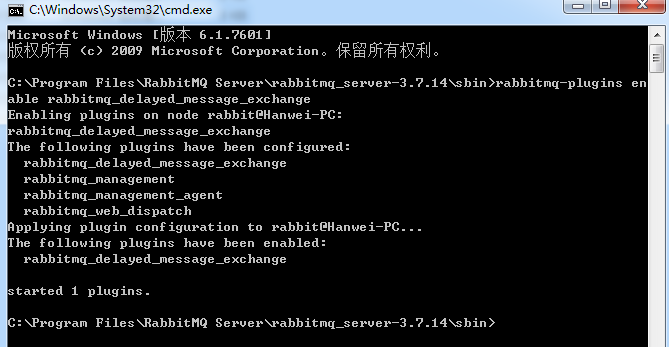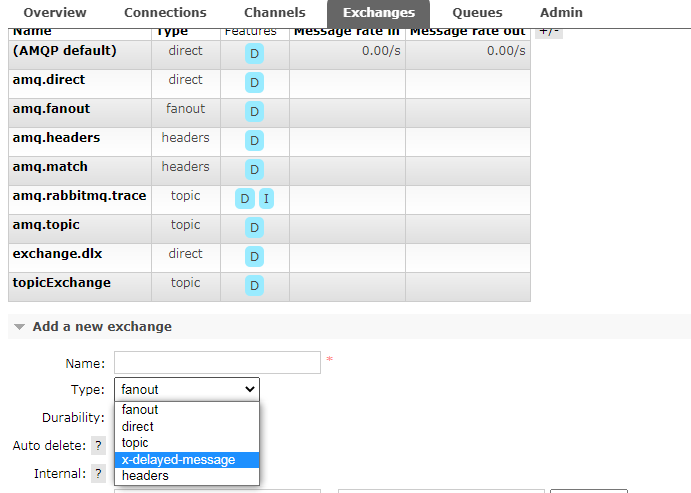准备工作
1、添加依赖
<dependency>
<groupId>org.springframework.boot</groupId>
<artifactId>spring-boot-starter-amqp</artifactId>
</dependency>
<dependency>
<groupId>org.springframework.boot</groupId>
<artifactId>spring-boot-starter-web</artifactId>
</dependency>
2、修改配置文件
application.yml
server:
port: 8080
spring:
# 配置RabbitMQ服务器
rabbitmq:
host: localhost
port: 5672
username: guest
password: guest
listener:
simple:
# 手动应答
acknowledge-mode: manual
# 限流
prefetch: 1
# 最少消费者数量
concurrency: 1
# 最多消费者数量
max-concurrency: 10
# 支持重试
retry:
enabled: true
Queue模式
简单模式
配置类
@Configuration
public class RabbitConfig {
//org.springframework.amqp.core.Queue
@Bean
public Queue queue(){
return new Queue("boot_queue");
}
}
生产者controller
@RestController
public class SimpleController {
@Resource
private RabbitTemplate rabbitTemplate;
@GetMapping("/producer")
public String producer(String msg){
//发送的对象必须实现序列化接口
Map<String,Object> map = new HashMap<>();
map.put("msg",msg);
map.put("user",new User("lucy",18));
rabbitTemplate.convertAndSend("boot_queue",map);
return "ok";
}
}
消费者
@Component
public class SimpleConsumer {
//接取对象的时候,使用和发送时相同的类型就可以
@RabbitListener(queues = {"boot_queue"})
public void consumer(Map<String,Object> map){
System.out.println("简单模式消费者:" + map);
}
}
工作模式
生产者与简单模式中相同
1、在yml配置文件中,声明手动应答和QOS限流
spring:
rabbitmq:
listener:
simple:
# 手动应答
acknowledge-mode: manual
# 限流
prefetch: 1
2、消费者中,进行手动应答
@Component
public class SimpleConsumer {
@RabbitListener(queues = {"boot_queue"})
public void consumer(Map<String,Object> map, Channel channel, Message message){
System.out.println("简单模式消费者:" + map);
try {
//进行手动提交
channel.basicAck(message.getMessageProperties().getDeliveryTag(),false);
} catch (IOException ioException) {
ioException.printStackTrace();
}
}
}
Exchange模式(订阅模式)
路由模式(direct)
配置类
@Configuration
public class RabbitConfig {
@Bean
public Queue redQueue(){
return new Queue("redQueue");
}
@Bean
public Queue greenQueue(){
return new Queue("greenQueue");
}
@Bean
public DirectExchange directExchange(){
return new DirectExchange("directExchange");
}
@Bean
public Binding bindingRed(Queue redQueue,DirectExchange directExchange){
//将队列redQueue绑定到directExchange,路由键是red
return BindingBuilder.bind(redQueue).to(directExchange).with("red");
}
@Bean
public Binding bindingGreen(Queue greenQueue,DirectExchange directExchange){
//将队列greenQueue绑定到directExchange,路由键是green
return BindingBuilder.bind(greenQueue).to(directExchange).with("green");
}
}
生产者
@RestController
public class SimpleController {
@Resource
private RabbitTemplate rabbitTemplate;
@GetMapping("/colorProducer")
public String colorProducer(){
for (int i = 0; i < 10; i++) {
//发送消息到exchange,参数1:交换机名,参数2:路由键,参数3:消息
rabbitTemplate.convertAndSend("directExchange","red","红色" + i);
}
for (int i = 0; i < 10; i++) {
rabbitTemplate.convertAndSend("directExchange","green","绿色" + i);
}
return "ok";
}
}
消费者
@Component
public class SimpleConsumer {
//声明一个消费者,接收redQueue队列消息
@RabbitListener(queues = {"redQueue"})
public void redConsumer(String msg,Channel channel,Message message){
System.out.println("红色消费者:" + msg);
try {
channel.basicAck(message.getMessageProperties().getDeliveryTag(),false);
} catch (IOException ioException) {
ioException.printStackTrace();
}
}
//声明一个消费者,接收greenQueue队列消息
@RabbitListener(queues = {"greenQueue"})
public void greenConsumer(String msg,Channel channel,Message message){
System.out.println("绿色消费者:" + msg);
try {
channel.basicAck(message.getMessageProperties().getDeliveryTag(),false);
} catch (IOException ioException) {
ioException.printStackTrace();
}
}
}
广播模式(fanout)
配置类
@Configuration
public class RabbitConfig {
@Bean
public Queue queue1(){
return new Queue("queue1");
}
@Bean
public Queue queue2(){
return new Queue("queue2");
}
@Bean
public FanoutExchange fanoutExchange(){
return new FanoutExchange("fanoutExchange");
}
@Bean
public Binding bindingQueue1(Queue queue1,FanoutExchange fanoutExchange){
//将队列queue1绑定到fanoutExchange
return BindingBuilder.bind(queue1).to(fanoutExchange);
}
@Bean
public Binding bindingQueue2(Queue queue2,FanoutExchange fanoutExchange){
//将队列queue2绑定到fanoutExchange
return BindingBuilder.bind(queue2).to(fanoutExchange);
}
}
生产者
@RestController
public class SimpleController {
@Resource
private RabbitTemplate rabbitTemplate;
@GetMapping("/fanoutProducer")
public String fanoutProducer(){
for (int i = 0; i < 10; i++) {
//发送消息到exchange,参数1:交换机名,参数2:路由键,参数3:消息
rabbitTemplate.convertAndSend("fanoutExchange","","广播模式:" + i);
}
return "ok";
}
}
消费者
@Component
public class SimpleConsumer {
//声明一个消费者,接收queue1队列消息
@RabbitListener(queues = {"queue1"})
public void queue1Consumer(String msg,Channel channel,Message message){
System.out.println("queue1:" + msg);
try {
channel.basicAck(message.getMessageProperties().getDeliveryTag(),false);
} catch (IOException ioException) {
ioException.printStackTrace();
}
}
//声明一个消费者,接收queue2队列消息
@RabbitListener(queues = {"queue2"})
public void queue2Consumer(String msg,Channel channel,Message message){
System.out.println("queue2:" + msg);
try {
channel.basicAck(message.getMessageProperties().getDeliveryTag(),false);
} catch (IOException ioException) {
ioException.printStackTrace();
}
}
}
主题模式(topic)
配置类
@Configuration
public class RabbitConfig {
@Bean
public Queue queueXian(){
return new Queue("queueXian");
}
@Bean
public Queue queueBeijing(){
return new Queue("queueBeijing");
}
@Bean
public TopicExchange topicExchange(){
return new TopicExchange("topicExchange");
}
@Bean
public Binding bindingXian(Queue queueXian,TopicExchange topicExchange){
//将队列redQueue绑定到directExchange,路由键是red
return BindingBuilder.bind(queueXian).to(topicExchange).with("*.xian");
}
@Bean
public Binding bindingBeijing(Queue queueBeijing,TopicExchange topicExchange){
//将队列greenQueue绑定到directExchange,路由键是green
return BindingBuilder.bind(queueBeijing).to(topicExchange).with("*.beijing");
}
}
生产者
@RestController
public class SimpleController {
@Resource
private RabbitTemplate rabbitTemplate;
@GetMapping("/topicProducer")
public String topicProducer(){
for (int i = 0; i < 10; i++) {
rabbitTemplate.convertAndSend("topicExchange","order.xian","西安订单" + i);
}
for (int i = 0; i < 10; i++) {
rabbitTemplate.convertAndSend("topicExchange","order.beijing","北京订单" + i);
}
for (int i = 0; i < 10; i++) {
rabbitTemplate.convertAndSend("topicExchange","back.xian","西安退货" + i);
}
for (int i = 0; i < 10; i++) {
rabbitTemplate.convertAndSend("topicExchange","order.beijing","北京退货" + i);
}
return "ok";
}
}
消费者
@Component
public class SimpleConsumer {
//声明一个消费者,接收队列queueXian队列消息
@RabbitListener(queues = {"queueXian"})
public void queueXianConsumer(String msg,Channel channel,Message message){
System.out.println("西安仓:" + msg);
try {
channel.basicAck(message.getMessageProperties().getDeliveryTag(),false);
} catch (IOException ioException) {
ioException.printStackTrace();
}
}
//声明一个消费者,接收队列queueBeijing队列消息
@RabbitListener(queues = {"queueBeijing"})
public void queueBeijingConsumer(String msg,Channel channel,Message message){
System.out.println("北京仓:" + msg);
try {
channel.basicAck(message.getMessageProperties().getDeliveryTag(),false);
} catch (IOException ioException) {
ioException.printStackTrace();
}
}
}
死信、延迟队列
死信队列
死信生成的三个条件
- 消息被拒绝(basic.reject / basic.nack),并且requeue = false
- 消息TTL过期
- 队列达到最大长度
模拟消息丢失
public class Producer {
public static final String QUEUE_NAME = "normalQueue";
public static final String EXCHANGE_NAME = "normalExchange";
public static void main(String[] args) throws IOException, TimeoutException {
Connection connection = ConnectionUtils.getConnection();
Channel channel = connection.createChannel();
channel.exchangeDeclare(EXCHANGE_NAME,"fanout");
Map<String,Object> map = new HashMap<>();
map.put("x-max-length",25);
channel.queueDeclare(QUEUE_NAME, false, false, false, map);
for (int i = 0; i < 100; i++) {
String message = "hello rabbitmq world!!"+i;
channel.basicPublish("",QUEUE_NAME,null,message.getBytes());
}
System.out.println("send ok!");
connection.close();
}
}

通过死信队列接收这75条消息
public class Producer {
public static final String QUEUE_NAME = "normalQueue";
public static final String EXCHANGE_NAME = "normalExchange";
public static void main(String[] args) throws IOException, TimeoutException {
Connection connection = ConnectionUtils.getConnection();
Channel channel = connection.createChannel();
channel.exchangeDeclare(EXCHANGE_NAME,"fanout");
Map<String,Object> map = new HashMap<>();
map.put("x-max-length",25); //生成死信
map.put("x-dead-letter-exchange","deadExchange"); //产生死信时发到哪个交换机上
map.put("x-dead-letter-routing-key","deadletter"); //声明routingkey
channel.queueDeclare(QUEUE_NAME, false, false, false, map);
channel.queueBind(QUEUE_NAME,EXCHANGE_NAME,"");
channel.exchangeDeclare("deadExchange","direct");
channel.queueDeclare("deadQueue",false,false,false,null);
channel.queueBind("deadQueue","deadExchange","deadletter");
for (int i = 0; i < 100; i++) {
String message = "hello rabbitmq world!!"+i;
channel.basicPublish("",QUEUE_NAME,null,message.getBytes());
}
System.out.println("send ok!");
connection.close();
}
}

延迟队列
延迟队列是一个特殊的死信队列
1、按存活时间过期进入死信队列
2、普通消息没有消费者处理
插件实现
在rabbitmq 3.5.7及以上的版本提供了一个插件(rabbitmq-delayed-message-exchange)来实现延迟队列功能。同时插件依赖Erlang/OPT 18.0及以上。
1、下载
https://www.rabbitmq.com/community-plugins.html
2、安装
插件格式为ez,将文件复制到插件目录plugins
3、启动插件
rabbitmq-plugins enable rabbitmq_delayed_message_exchange

4、查看

5、main方法实现
依赖
<dependency>
<groupId>com.rabbitmq</groupId>
<artifactId>amqp-client</artifactId>
<version>5.9.0</version>
</dependency>
生产者
public class Send {
static final String exchangeName = "test_exchange";
static final String queueName = "test_queue";
static final String routingKey = "test_queue";
public static void main(String[] args) throws IOException, TimeoutException {
//建立连接,创建通道
ConnectionFactory fc = new ConnectionFactory();
fc.setHost("192.168.2.100");
fc.setPort(5672);
fc.setUsername("guest");
fc.setPassword("guest");
Connection conn = fc.newConnection();
Channel channel = conn.createChannel();
//配置交换机类型
Map<String, Object> map = new HashMap<>();
map.put("x-delayed-type", "direct");
//创建路由
channel.exchangeDeclare(exchangeName, "x-delayed-message",false, false,map);
//创建队列
channel.queueDeclare(queueName, true, false, false, null);
//绑定路由、队列
channel.queueBind(queueName, exchangeName, routingKey);
String msg = "延时消息";
//配置延时时间
AMQP.BasicProperties.Builder builder = new AMQP.BasicProperties.Builder();
Map headers = new HashMap();
headers.put("x-delay", 9000);
builder.headers(headers);
AMQP.BasicProperties properties = builder.build();
//发送消息
channel.basicPublish(exchangeName, queueName, properties, msg.getBytes());
channel.close();
conn.close();
}
}
消费者和以前相同
6、Boot实现
依赖
<dependency>
<groupId>org.springframework.boot</groupId>
<artifactId>spring-boot-starter-amqp</artifactId>
<version>2.4.2</version>
</dependency>
配置文件和之前一样
配置类
@Configuration
public class RabbitMQConfig {
public static final String exchangeName = "test_exchange";
public static final String queueName = "test_queue";
public static final String routingKey = "test_queue";
/**
* 创建延迟队列
*/
@Bean
public Queue createQueue(){
return QueueBuilder.durable(queueName).build();
}
/**
* 创建路由
*/
@Bean
public CustomExchange createExchange(){
Map<String,Object> map = new HashMap<String,Object>();
map.put("x-delayed-type", "direct");
return new CustomExchange(
exchangeName, "x-delayed-message", true, false, map);
}
/**
* 绑定路由与队列
*/
@Bean
public Binding exchangeBindingQueue(){
return BindingBuilder.bind(createQueue()).
to(createExchange()).with(routingKey).noargs();
}
}
生产者
/**
* 延迟消息 发布者
*/
@RestController
public class SendController {
@Autowired
RabbitTemplate rabbitTemplate;
@GetMapping("/send")
public String sendMsg(){
String msg = "测试延时消息|"+LocalDateTime.now();
//ES6
rabbitTemplate.convertAndSend(RabbitMQConfig.exchangeName, RabbitMQConfig.routingKey, msg, (message) ->{
message.getMessageProperties().setHeader("x-delay", 9000); //延迟9秒
return message;
});
return "发送消息成功!";
}
}